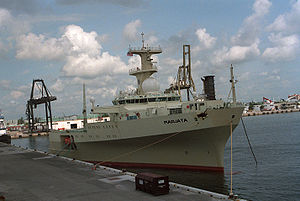- Marjata
-

Marjata in Port Everglades, Florida in 1994.Career (Norway) 
Name: F/S Marjata Owner: Norwegian Defence Research Establishment Operator: Norwegian Intelligence Service Ordered: 1991 Builder: Langsten shipyard, Aker Yards Launched: 18. December 1992 Commissioned: 1995 Homeport: Karljohansvern, Horten Status: In active service General characteristics Type: Military intelligence ship (ELINT) Displacement: unknown Length: unknown Beam: unknown Draught: unknown Propulsion: unknown Speed: unknowk Complement: unknown Aviation facilities: Helipad The F/S «Marjata» is a purpose-built electronic intelligence collection vessel (ELINT). She is the third ship that bears the name «Marjata», all of which has been used for military intelligence purposes by the Norwegian Armed Forces. She is owned by the Norwegian Defence Research Establishment, but operated by the Norwegian Intelligence Service, and is considered to be one of the most advanced ships of her kind in the world. Her main role is surveillance of the Russian Northern fleet`s activity in the Barents Sea, but is constructed for operations all over the world. She operates in international waters close to the Russian border. The Marjata officially serves as a research ship for the Norwegian Intelligence Service.
Contents
General
It is a Ramform type ship-design with an unusual hull shape. The shape of the hull is characteristic with a sharp bow, sinusoidal waterline, a descending rear body that ends in a straight cut-off stern where the ship has the largest width. Because of the very large width of the ship it will have an operational metacentric height of about 16 meters. The ship can continue to operate even with large parts of the interior under the waterline, when the ship's exact trimming is uncritical. The same goes for cargo shift, if the ship is exposed to icing or large amounts of water on deck. This makes «Marjata» a very stable sensor platform, she is also built with a very low noise signature, so that the ship itself does not interfere with the onboard sensors. «Marjata» also has large internal bay for computing and analyzing of reconnaissance data. The Ramform type ships are often used for geological surveys of the seabed. «Marjata» is well suited for operation in arctic conditions for prolonged periods of time.[1][2]
«Marjata» and the Kursk tragedy
For more details on this topic, see Russian submarine Kursk explosion.The various ships that have borne the name «Marjata» has always been looked upon with disapproval by the Russian and former Soviet, authorities. During and after the raising of the sunken Russian submarine "Kursk," Norwegian authorities were criticized by the Russian side because the ship had been too aggressive and would have disrupted the work. The ship was also in the area when the accident occurred. It was located 19 kilometer away when it was registered an explosion that was interpreted as a "soft explosion". A little while later an earthquake measuring device picked up a second explosion which is thought to have occurred when "Kursk" hit the seabed. This secondary event is estimated to be equal to two tons of TNT.[3][4] After the incident it emerged claims that the «Marjata» had not observed any abnormalities, but this claim has several military sources doubted the correctness of.[5] During the salvage of the Kursk, there was also considerable disagreement about «Marjata» position and actions.[6][7]
In general Russian authorities in accordance with Norwegian Vice Admiral Einar Skorgen thinks the ship operates too close to Russian waters.[8]
Images of «Marjata»
External links
- Norwegian Defence Research Establishment
- The Norwegian Intelligence Service (NIS)
- Norwegian Armed Forces
References
- ^ "The research-ship "Marjata" (in Norwegian). Norwegian Armed Forces. 23. January 2002. http://www.mil.no/etjenesten/start/article.jhtml?sourceID=581651&source=ftd. Retrieved 27 February 2010.
- ^ "Marjata Intelligence collection ship". military-today.com. http://www.military-today.com/navy/marjata.htm. Retrieved 27 February 2010.
- ^ "Norway, Russia differ on accident". The Hindu. 23. August 2000. http://www.hindu.com/2000/08/23/stories/0123000a.htm. Retrieved 27 February 2010.
- ^ "A blast. A deluge. Then death in a metal tomb". The Guardian. 20. August 2000. http://www.guardian.co.uk/world/2000/aug/20/kursk.russia. Retrieved 27 February 2010.
- ^ "«Marjata» did not observe the explosion" (in Norwegian). Dagbladet. 15. August 2000. http://www.dagbladet.no/nyheter/2000/08/15/215383.html. Retrieved 27 February 2010.
- ^ "Complaints about Norwegian presence" (in Norwegian). Aftenposten. 12. June 2002. http://www.aftenposten.no/nyheter/uriks/article344119.ece?contentType=tips. Retrieved 27 February 2010.
- ^ "Oslo is perplexed at the accusations that the Norwegian Air Force implements dangoures maneuvers close to the Kursk". wps.ru. 31. July 2001. http://www.wps.ru/en/pp/kursk/2001/07/31/2.html. Retrieved 27 February 2010.
- ^ "Icy between Norway and Russia" (in Norwegian). Dagbladet. 25. April 2001. http://www.dagbladet.no/nyheter/2001/04/25/254089.html. Retrieved 27 February 2010.
Categories:- Cold War auxiliary ships
- Ships built in Norway
- Naval ships of Norway
- 1992 ships
Wikimedia Foundation. 2010.
